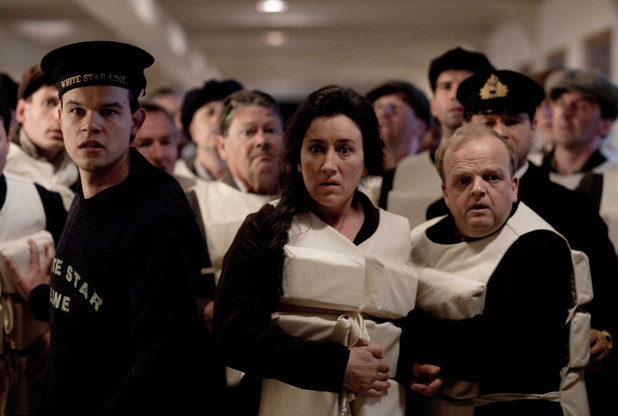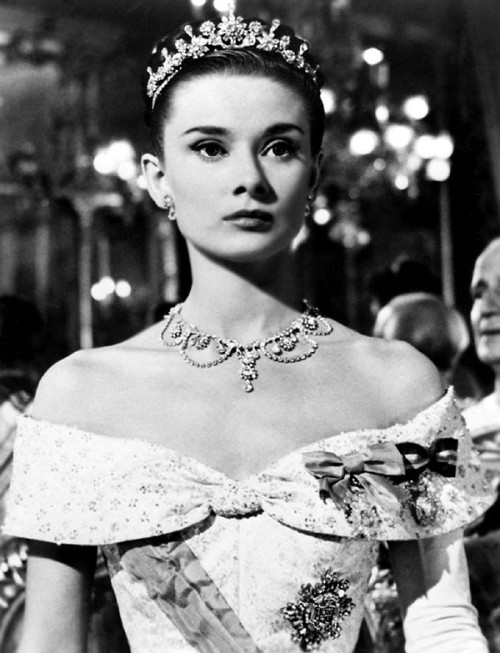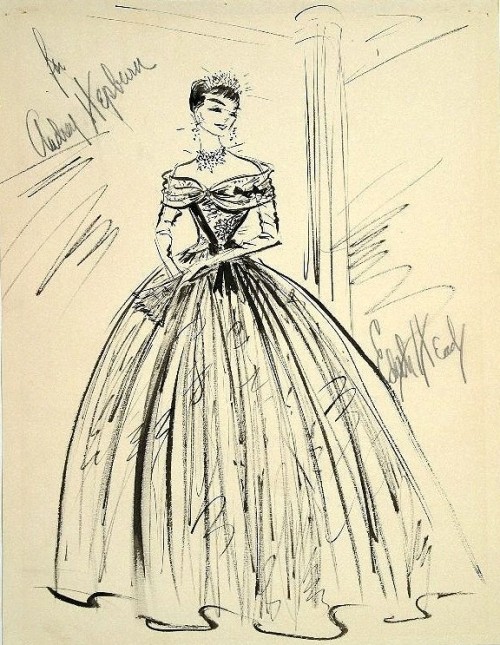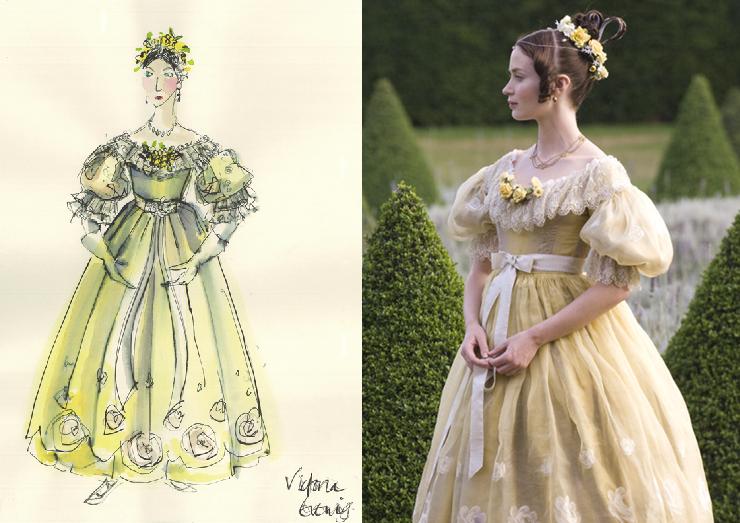Warning, this analysis contains spoilers for Little Dorrit. Tread with caution!
 |
| Source |
 |
| Source |
The book and film are set in the late 1820's. Though Amy's dress shown above is by no means fashionable, the natural waistline and full sleeves show the time period well.
When she's outside her home at the Marshalsea debtor's prison, Amy pairs this dress with a simple cape and a dated straw bonnet.
 |
| I don't believe her bangs are too period accurate, but they show the character's sweetness and shyness well. |
 |
| Source |
I think it's interesting that the first outfit we see Fanny wearing is very detailed and showy, but made out of some sort of worn imitation velvet.
Amy and Fanny's lives change dramatically when it's discovered that the Dorrit family is actually entitled to a large sum of money. Of course, Fanny and Edward (Amy and Fanny's brother, played by Arthur Darvill of Doctor Who fame) move back in, and the entire family sets off for Italy.
Of course, the Dorrit family spares no expense when buying their new wardrobe, and both girls wear gowns that feature expensive material, fashionable construction, and intricate detail.
When the two sisters actually start wearing more than one outfit, it becomes evident that both of them wear certain colors very often. Amy wears a purple gown in every scene but one (when she's wearing black in mourning for her father), and Fanny tends to wear a lot of green (although not exclusively).
 |
| Source |
 |
| I think it's interesting that her dress has an empire waistline. It shows that some empire-waist dresses were still popular by the end of the 1820's. |
Though they have a significantly larger amount of money by this point in the series, Amy and Fanny's personalities show through in their clothing in much the same way as when they were poor. Amy still prefers to keep her wardrobe very simple, with minimal details on her gowns.
 |
| Her dress is a very light shade of purple, but purple nonetheless. |
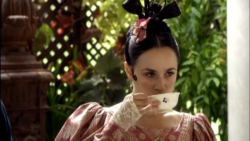 |
| Source |
 |
| I see you creeping back there, Arthur Darvill. |
First, we see that both Amy and Fanny are wearing their customary colors, purple and green. Their gowns are very similar in cut, with the natural waist line, structured bodice, and puffy sleeves of the late 1820's. Both of them wear simple necklaces and fingerless lace gloves. And that's pretty much where the similarities end. Amy's dress is a simple satin with a buckle on the waistband, whereas Fanny's gown is decked out in lace trim.
The hair is another interesting point of contrast. Of course, my eye is immediately drawn to Fanny's peacock feather extravaganza (very 1830's), but Amy's tiny attempts at hair loops are also very interesting. She's trying to follow the fashion, but is very timid about it. Meanwhile, Fanny is pulling out all the stops (which might say something about each girl's attitude towards their new lifestyle). Another interesting point about the hair is the part that frames each girl's face. Fanny's hair is severely pulled back from her face, with one curl intentionally plastered to her temple. Amy's hair is more natural, with lighter curls framing her face and neck.
Not to draw attention to anything inappropriate, but Fanny's neckline is significantly lower than Amy's, which was actually rather unfashionable for the time. Necklines on evening dresses really didn't get that low until the early 1840's, over ten years later. This paired with Fanny's makeup tells me that Fanny still yearns for her showgirl days. Although she claims to want to leave the past behind her, her wardrobe tells a different tale.
All good things must come to an end, the Dorrits' wealth included. When Mr. Merdle (the Bernie Madoff of the 19th century) commits suicide because of his unraveling financial scam, the Dorrits lose all of their investments and are sent back to poverty. Well, Amy is. Fanny has escaped the clutches of financial insecurity by marrying Edmund Sparkler, Mr. Merdle's flamboyant stepson.
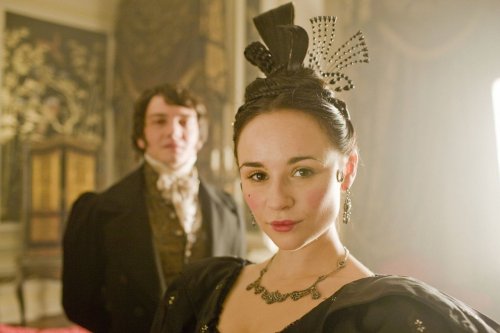 |
| Source |
Amy stays with her sister and the in-laws for a while, but understandably grows weary of it. When she goes to help a friend (or more than a friend? Perhaps, it's too lengthy to explain here, the story has a... Dickensian amount of characters and plot lines) who has found himself in the Marshalsea, she is most likely in half mourning, and so her purple-wearing tendencies are justified.
 |
| Source |
Amy's choice of clothing here is very simple. Her dress is dark, structured, and tailored well, and her sleeves are almost unfashionably slim. She's back to wearing her hair with straight bangs, and her bonnet simply matches the dress, with no more fuss required. Though it's very basic, this costume feels very strong to me, and it's more mature than the girlish things Amy's worn up until this point. It shows her character change well. She goes from a young, shy seamstress who is nicknamed "Little Dorrit," to a determined woman who has seen her share of sorrows and has the courage to soldier on.
Another interesting point for comparison and contrast is that both sisters get married at different points in the series: Fanny (as mentioned above) to Edmund Sparkler, and Amy to... someone else. I'll keep one spoiler unspoiled for you.
Although we don't see much of Fanny's dress in this brief shot, it is pretty clear that her personality is just as present on her wedding day as it is in every other scene. Makeup? Check. Expensive details? Check (in the form of the gold embroidery trim). Low neckline? Check. Jewels? Check. Enormous pillow-sleeves? Check. The only thing that's missing is a crazy hairdo, which is replaced by a starburst tiara. Also, I have to say, I'm in love with the way she draped her veil over her massive sleeves.
Now, you may be asking yourself, "Why is Fanny wearing white? Queen Victoria hasn't gotten married at this point, and Queen Victoria started the tradition of white bridal gowns." Well, the short answer is that this (semi) anachronism pops up in a lot of period films. Modern audiences want to see brides wearing white. It's just our thing. However, Her Majesty wasn't the first bride in the universe to wear white. She did popularize it, but many ladies' magazines prior to the Victorian Era advised brides to wear white because of its connotations with purity. In Fanny's case, that's pretty ironic.
Amy's wedding look is much more typical of the average pre-Victorian bride. Like most women of the time, Amy is simply wearing the best dress she owns, which appears to be the purple evening gown from before. She pairs it with her lace gloves, a lace veil, and plenty of flowers (purple, of course) in her hand and hair.
The way Amy wears her hair is really interesting to me. She's got this totally off-the-wall curly side ponytail thing going on, and still manages to work in her trademark bangs. This looks like it's more of a character development thing and less of an actual historical hairstyle. To me, it shows how Amy has blossomed as a woman, (partially loose hair, flowers) but still retains her old sweetness (bangs).
Amy and Fanny couldn't be more different, and that's masterfully shown in the series. I heartily recommend Masterpiece Classic's adaptation of Little Dorrit. Trust me, I haven't spoiled even a fraction of the massive, beautiful story. See you next week.
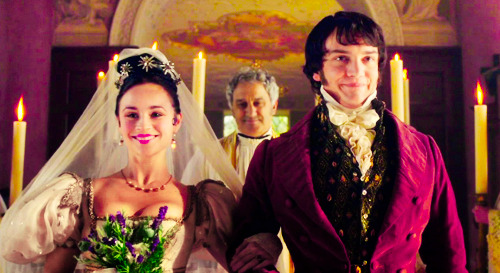 |
| I would like to call attention to Edmund's face. |
Now, you may be asking yourself, "Why is Fanny wearing white? Queen Victoria hasn't gotten married at this point, and Queen Victoria started the tradition of white bridal gowns." Well, the short answer is that this (semi) anachronism pops up in a lot of period films. Modern audiences want to see brides wearing white. It's just our thing. However, Her Majesty wasn't the first bride in the universe to wear white. She did popularize it, but many ladies' magazines prior to the Victorian Era advised brides to wear white because of its connotations with purity. In Fanny's case, that's pretty ironic.
 |
| Source |
The way Amy wears her hair is really interesting to me. She's got this totally off-the-wall curly side ponytail thing going on, and still manages to work in her trademark bangs. This looks like it's more of a character development thing and less of an actual historical hairstyle. To me, it shows how Amy has blossomed as a woman, (partially loose hair, flowers) but still retains her old sweetness (bangs).
Amy and Fanny couldn't be more different, and that's masterfully shown in the series. I heartily recommend Masterpiece Classic's adaptation of Little Dorrit. Trust me, I haven't spoiled even a fraction of the massive, beautiful story. See you next week.











